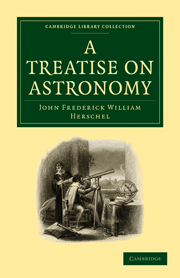Refine listing
Actions for selected content:
16950 results

Memoir of Augustus De Morgan
- With Selections from His Letters
-
- Published online:
- 29 August 2010
- Print publication:
- 29 July 2010
- First published in:
- 1882

A Treatise on Astronomy
-
- Published online:
- 29 August 2010
- Print publication:
- 20 July 2009
- First published in:
- 1833
Chapter 9 - Neutron stars, pulsars, pulsar wind nebulae, and more supernova remnants
-
- Book:
- Exploring the X-ray Universe
- Published online:
- 05 June 2012
- Print publication:
- 26 August 2010, pp 123-142
-
- Chapter
- Export citation
Chapter 1 - Birth and childhood of X-ray astronomy
-
- Book:
- Exploring the X-ray Universe
- Published online:
- 05 June 2012
- Print publication:
- 26 August 2010, pp 1-11
-
- Chapter
- Export citation
Contents
-
- Book:
- Exploring the X-ray Universe
- Published online:
- 05 June 2012
- Print publication:
- 26 August 2010, pp v-ix
-
- Chapter
- Export citation
List of acronyms
-
- Book:
- Exploring the X-ray Universe
- Published online:
- 05 June 2012
- Print publication:
- 26 August 2010, pp x-xii
-
- Chapter
- Export citation
Chapter 10 - Cataclysmic variable stars
-
- Book:
- Exploring the X-ray Universe
- Published online:
- 05 June 2012
- Print publication:
- 26 August 2010, pp 143-170
-
- Chapter
- Export citation
Chapter 16 - The diffuse X-ray background
-
- Book:
- Exploring the X-ray Universe
- Published online:
- 05 June 2012
- Print publication:
- 26 August 2010, pp 325-339
-
- Chapter
- Export citation
Chapter 6 - Active stellar coronae
-
- Book:
- Exploring the X-ray Universe
- Published online:
- 05 June 2012
- Print publication:
- 26 August 2010, pp 60-83
-
- Chapter
- Export citation
Chapter 2 - X-ray emission and interaction with matter
-
- Book:
- Exploring the X-ray Universe
- Published online:
- 05 June 2012
- Print publication:
- 26 August 2010, pp 12-17
-
- Chapter
- Export citation
Index
-
- Book:
- Exploring the X-ray Universe
- Published online:
- 05 June 2012
- Print publication:
- 26 August 2010, pp 354-358
-
- Chapter
- Export citation
Chapter 3 - Tools and techniques
-
- Book:
- Exploring the X-ray Universe
- Published online:
- 05 June 2012
- Print publication:
- 26 August 2010, pp 18-38
-
- Chapter
- Export citation
Chapter 11 - X-ray binaries
-
- Book:
- Exploring the X-ray Universe
- Published online:
- 05 June 2012
- Print publication:
- 26 August 2010, pp 171-241
-
- Chapter
- Export citation
Chapter 4 - Solar system X-rays
-
- Book:
- Exploring the X-ray Universe
- Published online:
- 05 June 2012
- Print publication:
- 26 August 2010, pp 39-50
-
- Chapter
- Export citation
Frontmatter
-
- Book:
- Exploring the X-ray Universe
- Published online:
- 05 June 2012
- Print publication:
- 26 August 2010, pp i-iv
-
- Chapter
- Export citation
Chapter 15 - Clusters of galaxies
-
- Book:
- Exploring the X-ray Universe
- Published online:
- 05 June 2012
- Print publication:
- 26 August 2010, pp 306-324
-
- Chapter
- Export citation
Chapter 17 - Gamma-ray bursts
-
- Book:
- Exploring the X-ray Universe
- Published online:
- 05 June 2012
- Print publication:
- 26 August 2010, pp 340-353
-
- Chapter
- Export citation
Plate section
-
- Book:
- Exploring the X-ray Universe
- Published online:
- 05 June 2012
- Print publication:
- 26 August 2010, pp -
-
- Chapter
- Export citation
Chapter 8 - Supernova explosions and their remnants
-
- Book:
- Exploring the X-ray Universe
- Published online:
- 05 June 2012
- Print publication:
- 26 August 2010, pp 97-122
-
- Chapter
- Export citation
Chapter 7 - Early-type stars
-
- Book:
- Exploring the X-ray Universe
- Published online:
- 05 June 2012
- Print publication:
- 26 August 2010, pp 84-96
-
- Chapter
- Export citation
